I am a developer and I have been working in online payment industry for quite some time now. I like how the projects I work has helped people pay faster and better. After working on few projects I started writing tutorials and I realized how beneficial they are, not only for the reader but even for the writer as well. While writing a tutorial or a blog you yourself have to research a lot and like this a long the way you learn too. That’s why I like it. I love technology and how it has made our life’s easier. I believe in a future where technology will be our companion rather than replacing us.
GraphQL with spring-boot-starter-graphql
Graphql developed by Facebook in 2012 is an exciting and quite new concept compared to REST and SOAP which have been around since 2000. I personally like how simple and easy it’s to use.
This quick tutorial will give you an idea of how to use GraphQl with spring boot in java. Finally, after 10 months of waiting GraphQL is integrated with the latest release of spring boot 2.7.0. With this release, spring-boot-starter-graphql replaces the current GraphQL java spring. For more details on this release check here.
What is GraphQL?
GraphQl is a query and manipulation language for developing APIs. Unlike traditional REST APIs GraphQl allows the client to specify which data is required and only return that data. To do the same thing with REST you’ll need multiple endpoints. This helps to develop lightweight manageable APIs. For information make sure to check out the official documentation.
GraphQL Schema
A GraphQL schema describes what the API can be queried for. I like to think of it as a blueprint of the API. The schema tells us what types and queries the API has. Most objects are normal objects that define the data. But there are two special types in the schema mentioned below, used for querying the data they are also the entry point of every GraphQL query.
Query Type: It’s like the GET method. Used to read the data.
Mutation Type: It’s used for the Create/ Update/Delete operations on the data.
What are we building?
In this article, we’ll see how you can start using this new graphql starter or simply migrate your existing project. Here, I am using my previous project that was built with graphql java spring.
Requirements
Setup you’ll need:
- Basic understanding of spring boot and GraphQL
- Existing graphql java project or clone one here
- Docker installed on your machine
- Intellij or IDE of your choice
- Postman for testing the API
Project Migration
Unlike before, with spring boot 2.7.0 we only need one dependency to integrate GraphQL in our project. So I started by upgrading the spring boot version to
Then I removed the previous graphql dependencies graphql-java-tools and graphql-spring-boot-starter.

And added the new spring boot graphql starter

After this, remove all the implemented Resolvers and clean the project by removing all the imports from graphql java spring.

Now our project is clean and updated with the new dependencies. According to the spring graphql documentation, the biggest changes come with the new annotated controllers. The default location for schema files are src/main/resources/graphql/**. This is the case here, so we don’t need to touch the graphql schema files. All files will be picked up automatically by spring graphql starter.
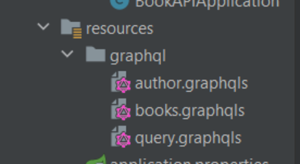
schema file location
You can also customize the schema file location in the application.properties. But here we’ll go with the defaults.

GraphQL Annotations
With Graphql spring java the resolvers component is needed to implement GraphQLQueryResolver or GraphQLMutationResolver classes. But with the spring boot starter graphql, it’s moved to an annotation-based programming model. In short previous resolvers are replaced by annotations:
![]()
And the @Controller component uses the annotated handler methods to bind and resolve graphql schema fields/queries.
Query Mapping
As the name suggests this annotation maps the handler method to the query type in graphql schema.

Query schema
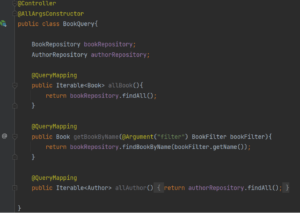
BookQuery class with annotated query methods
Now let’s configure our query methods by annotating them with @QueryMapping. For mapping query argument we can use the annotation @Argument. For having more flexibility you can also define alias names for the arguments for example
![]()
The query getBookByName has an argument filter in the schema and in the handler method, it’s bookFilter. So we need to define an alias with the @Argument(“filter”). If you forget to do this, your project will just deploy successfully but the query will end up with NPE. Which I wasted some time on, and later figured out it was just missing the right matching argument names.
Schema Mapping
This annotation maps and binds a handler with the field in the GraphQL schema, it can be used at the method or class level. It accepts two parameters typeName= and field=. It’s also the parent annotations of the other query-specific annotations.

We’ll need this annotation to resolve the authorfield type of the Book type.
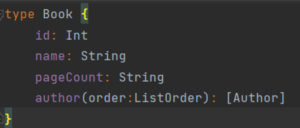
book type in the schema
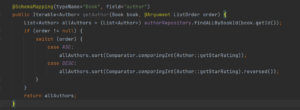
author resolver method with schema mapping annotation
Here we define the @SchemaMapping annotation with parameters
- typeName= Book, which is the type to which the author field belongs
- field= author, to specify which field of the specified typeName will be resolved by this handler method.
After, I defined the argument on the field, order with the @Argument annotation. As it has the same name order both in schema and handler method spring will map it automatically. Since we are defining the schema annotation at the method level the previous BookAuthorResolver class is unnecessary so I removed it and moved the method to the BookQuery class.
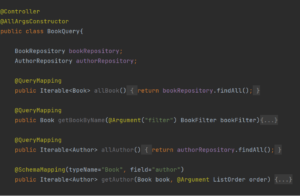
BookQuery class with query handler and author resolver methods
Mutation Mapping
This annotation maps handler methods with the mutation query in the GraphQL schema.

mutation schema
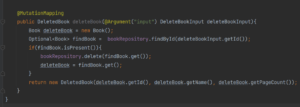
deleteBook method with mutation annotation
Just like we changed for the queryMapping, add the @MutationMapping to the mutation query method and annotate the mutation argument with @Argument(“input”) annotation with the alias.
Since Mutation and Query mapping annotations are meta-annotations of SchemaMapping, we can also replace them like this.

defining mutation method with @SchemaMapping annotation
TEST API
Now all the changes are done let’s build and run the project.
mvn clean install
Then deploy with docker.
docker-compose up -d

Let’s test one query first
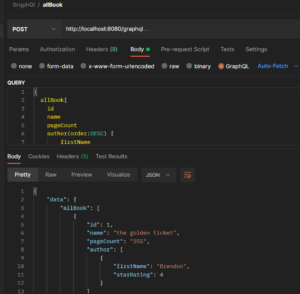
allBook query in postman
As mentioned in the specs, the new spring graphql starter uses Runtime wiring to register handler methods to the graphql.schema.Datafetcher. Therefore even if you annotate a handler method wrong like, instead of @QueryMapping you accidentally put @MutationMapping

You won’t see any errors but the result won’t be the one expected. So just be careful while annotating the handler methods.

Now let’s test one mutation.
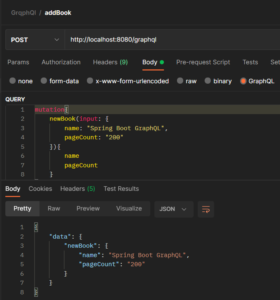
newBook mutation in postman
The API works as expected. I hope this quick article will help you get started with the new spring-boot-graphql-starter and play with the other cool features it has. You can check out this project on github here.
Sumitra, also published on the Médium website



Comment 1
septembre 10, 2022 at 10:19 am
Thanks for your blog, nice to read. Do not stop.